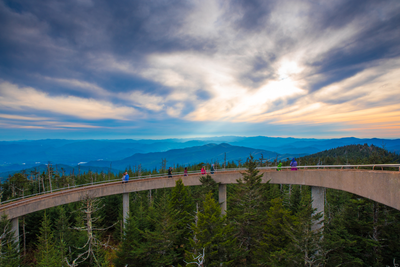GSMNP is the most visited national park in the U.S., and for good reason! More than just your average walk in the woods, the 850+ miles of hiking trails are filled with old-growth forests, scenic mountain scenery, wildflowers, waterfalls, and wildlife, not to mention the remnants of logging camps, historic buildings, and other fascinating traces of Appalachian history. So, how do you decide which trails in the Smokies to explore? Let us help you create your own hiking bucket list with this list of the top 10 hikes in Great Smoky Mountains National Park, ranked from easiest to hardest!
1. Cataract Falls
One of the easiest waterfall hikes in the Great Smoky Mountains, the trail to Cataract Falls is around 1 mile long one way. Located near the Sugarlands Visitor Center, you can easily combine it with other nature trails nearby, such as the Fighting Creek Nature Trail. Perfect for kids and families of all ages, everyone should have this hiking trail on their list!
2. The Gatlinburg Trail
Want a relatively flat trail you can walk or bike? The Gatlinburg Trail is ideal, at a little less than 4 miles long. You can access the trailhead in downtown Gatlinburg and travel to the Sugarlands Visitor Center. Also, it’s one of the only dog-friendly trails in Great Smoky Mountains National Park.
3. Kuwohi (formerly Clingmans Dome)

The 1-mile paved trail to the Kuwohi Observation Tower is by far one of the best hikes in Great Smoky Mountains National Park for the views. Not only is it the highest point at 6,6,43 feet, but the short but steep hike is accessible for kids and adults alike. On clear days, you can see about a hundred miles in every direction!
4. Grotto Falls
Grotto Falls Trail is 2.6 miles, with little elevation gain but a rewarding 25-foot waterfall– the only one you can walk behind in Great Smoky Mountains National Park! Keep going after the falls to reach the summit of Brushy Mountain or even further to Mount LeConte. Fun fact: Grotto Falls Trail is used by the llamas that take supplies to the top for the lodge
5. Rainbow Falls
Rainbow Falls Trail leads hikers to a waterfall, one of the most impressive falls in the Smoky Mountains. This trail is about 5.5 miles roundtrip and is considered a moderate hike. Rainbow Falls is the tallest single-drop waterfall in the national park at 80 feet. If you wish to make the hike a little more challenging, keep going for about 4 miles after the falls– you can take the trail all the way to the summit of Mount LeConte!
6. Abrams Falls

If you had to choose one waterfall hike, Abrams Falls Trail should be a top contender! Approximately 5 miles roundtrip, this hiking trail in Cades Cove features a 25-foot tall waterfall with an incredible volume of water rushing over the falls. As tempting as the pool below looks for swimming, resist the urge– strong currents make this area hazardous for swimming but a great place to sit, enjoy a picnic, and take photos!
7. Chimney Tops
One of the shortest and steepest Great Smoky Mountains National Park trails, Chimney Tops Trail is roughly a 3.3 miles roundtrip but a whopping 1487 feet of elevation gain in under 2 miles! It may be short, but the hundreds of stone stairs will pack a leg-pumpin’ punch! Due to the wildfires in 2016, you can’t go all the way to the top like you used to, but there’s still an incredible view at the new observation point.
8. Charlies Bunion
The hike to Charlies Bunion is moderately difficult at about 8 miles roundtrip. If you want to go hiking in the Smokies, see tremendous panoramic views, and also say you’ve hiked a portion of the Appalachian Trail, then you’ll definitely want to give this trail a try!
9. Alum Cave Trail

Alum Cave Trail is roughly 5 miles roundtrip to the Alum Cave Bluffs and back, but you can also continue a few more miles to reach Mount LeConte. This hike won’t be a cakewalk but will get your heart pumping. It features some of the most unique rock formations along the way, including Arch Rock, Inspiration Point, and of course, the towering 80-foot bluffs.
10. Ramsey Cascades
Ramsey Cascades is the tallest waterfall in the Smoky Mountains and one of the more challenging waterfall hikes. This 8-mile hike in the Greenbrier area of the national park has a total elevation gain of more than 2,000 feet. Most of the elevation is gained in the last few miles, so save your legs for the final grind to the finish!
Where to Stay
Now that you know our top 10 hikes in Great Smoky Mountains National Park, it’s time to grab your hiking gear and plan a trip! Find the perfect place to stay by browsing our Smoky Mountain cabin rentals. With convenient locations to Gatlinburg and Pigeon Forge, you can enjoy peaceful solitude, stunning mountain views from the deck, and easy access to all the beautiful trails nearby.













